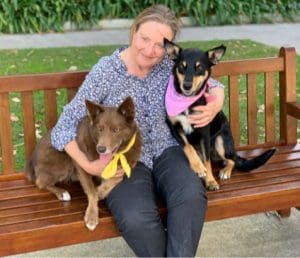UNIVERSITY of Sydney researchers have found no genetic evidence that the iconic Australian Kelpie shares canine ancestry with a dingo, despite Australian bush myths.
Although some Kelpie owners believe the dog was bred with the dingo to make them more resilient to the Australian climate, the research suggests this may be bush folklore.
The university’s research paper, published in the journal Genes, is the first peer-reviewed study of its kind to find that the domestic and wild dogs share no detectable common DNA in genes impacting coat colour and ear type.

Professor Claire Wade with Peppa and Cash (right). Photo by Vanessa Saines.
The university said some Kelpie owners and ‘old-timers’ believe the kelpie breed contains genes from the Australian dingo, Professor Claire Wade from the School of Life and Environmental Sciences said.
“It has been said that the dingo was mixed with the Kelpie, which originally came from Scotland, to produce a more-resilient and hardy dog that could withstand hot, dry Australian conditions.
“Our analysis shows there is no genetic evidence for this from any genes affecting the way the domestic and wild dogs look,” Professor Wade said.
The dog genetics expert said some people have come to believe there is a connection simply because the two dogs look similar. They both have pricked up ears, a similar body shape and hair texture, and some Kelpies are yellow or cream in colour.
“There’s a bit of Australiana and sentiment here.
“We wish the Australian Kelpie was somehow special or unique to us. But the breed has come from Scotland and the way we made it our own was by selecting it for our harsh climate,” Professor Wade said.
The study characterised known gene variants of both Kelpie types (Australian Kelpie —conformation; Australian working Kelpie — herding) and compared the variants present with those in sequenced Australian dingoes. Genes assessed included identified coat colour and ear type variants. None of the coat colour or ear type genes analysed offered support for a shared family history.
The Kelpie was bred from dogs brought to Australia in the late 1800s from Scotland. The university said they are a herding dog derived from the Scottish smooth collie or farm collie. There are two types of kelpies developed in Australia: the working Kelpie, which has been selected specifically to handle the Australian climate and working conditions, and the conformational Kelpie, which is usually a single colour all-over and is more likely to live in the city.
Dingoes are believed to have arrived in Australia more than 4000 years ago, most likely with Asian seafarers.
The Kelpie samples in the research were obtained as part of a larger genetic project helping breeders produce the best possible working dogs. Owners of working kelpies are invited to take part in a survey of current working dogs and their behaviours.
Were dingo/Kelpie crosses failures?
Consulting geneticist for the Working Kelpie Council Dr Don Robertson said author Bill Robertson has asserted that the late Alan Wilton, researcher on dingo DNA at the University of New South Wales, had examined DNA from working Kelpies and found evidence of dingo DNA.
“I have been unable to find this published anywhere other than in Bill’s book.
“However, Alan Wilton featured in Bill’s video and appeared to endorse the claim,” he said.
Dr Robertson said Professor Wade’s paper supports the belief held by many breeders of working Kelpies, that the progeny of acknowledged dingo/Kelpie cross matings failed as working sheep dogs and did not contribute their genes to future generations.
“When visiting the United Kingdom I observed all of the simple physical traits that characterise Kelpies in at least some working collies.
“Prick ears, short coats, and colours like cream can all be found in the working collie population in Britain, although at low frequencies,” he said.
“A dog with these Kelpie or dingo-like traits could be created by selection from the working collie gene pool,” just as Professor Wade suggests.
“Apart from the sentiment mentioned by Professor Wade, does it matter? A stockman or woman appreciates an effective working Kelpie derived from generations of selection in Australia, whether or not there is a trace of dingo DNA.”
Funding for the latest Kelpie research came from Australian Research Council, AgriFutures Australia and the Working Kelpie Council.



HAVE YOUR SAY